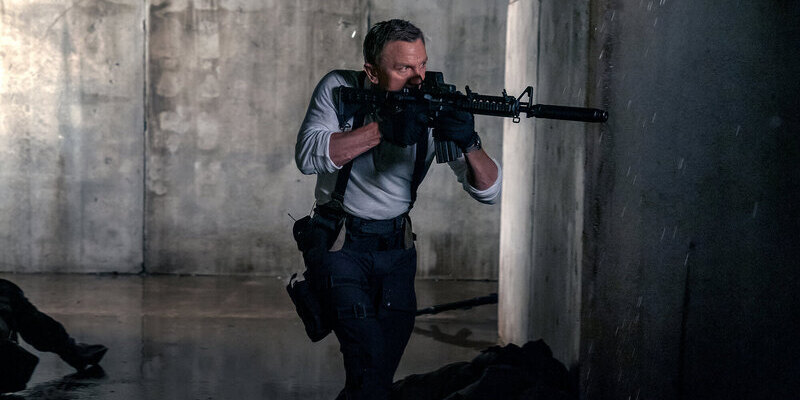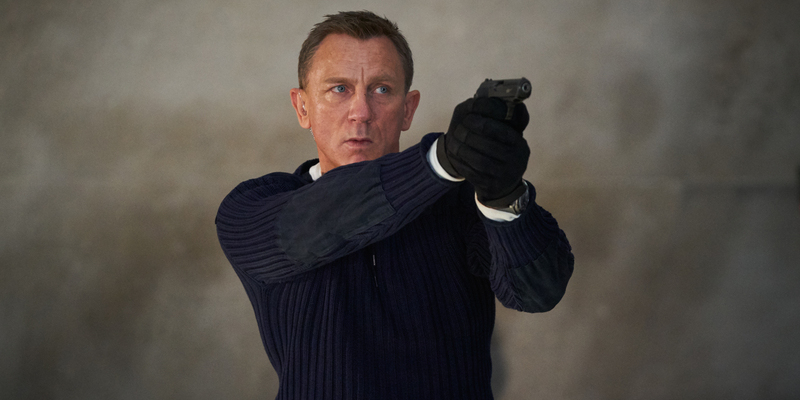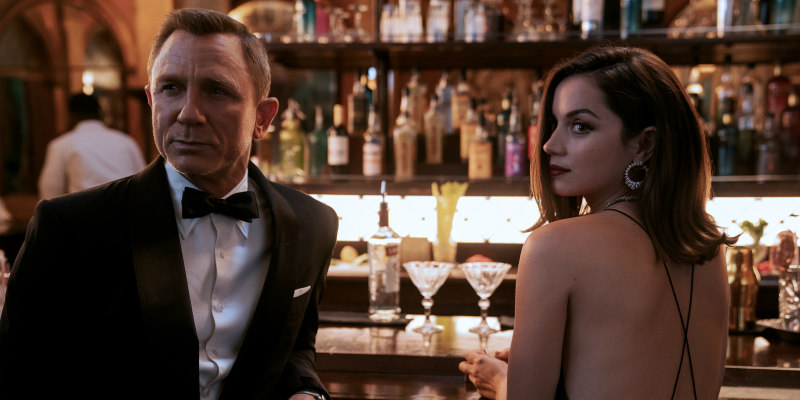
Review by
Eric Hillis
Directed by: Cary Joji Fukunaga
Starring: Daniel Craig, Rami Malek, Léa Seydoux, Ana de Armas, Lashana Lynch, Ben Whishaw, Naomie Harris,
Jeffrey Wright, Christoph Waltz, Rory Kinnear, Ralph Fiennes, Dali Benssalah, Billy Magnussen, David Dencik

Daniel Craig's tenure in the tux ends with a literal bang in
No Time to Die. His final film in the role opens with several bangs too. But between the
bombastic opening 45 minutes and the explosive climax there's an awfully
long whimper.
Cary Joji Fukunaga, who is remarkably the first American to direct a
Bond movie, lays down a strong marker in a beautifully constructed opening
sequence that flashes back to the childhood of
Lea Seydoux's Madeleine Swann. We then cut to some time after
the end of the risible previous entry
Spectre, with Bond and Swann travelling to Rome to visit the grave of his previous
love, Vesper Lynd, as memorably played by Eva Green in Craig's debut Casino Royale. Attacked by a small army of goons, Bond assumes he's been betrayed by
Swann, whom he sticks on a train and bids farewell.

Five years later, in a nod to Dr. No, Bond is living in Jamaica, where he's approached by the CIA's Felix
Leiter (Jeffrey Wright, who beams with the glow of a man realising a
childhood dream of appearing in a Bond movie) with one of those classic "Do
it for us one more time" proposals. Thus Bond is dragged into an adventure
involving a genocidal plot, all while negotiating a reunion with a figure
from the past.
Despite everyone telling me I'm clearly mad, I've long believed the best
Bond movie to be 1969's On Her Majesty's Secret Service. It's got the best score, the best (and most beautiful) Bond girl in Diana
Rigg (RIP), some cracking set-pieces directed by an ahead of his time Peter
Hunt, French New Wave influenced meta stylings, and, yes, the best Bond in
George Lazenby, who unlike every other actor that has played the role, feels
like a man who embodies his era rather than clashes with it. I feel somewhat
redeemed by No Time to Die, which takes its cues - both of a thematic and soundtrack variety - from
the only Bond movie that could genuinely be considered a masterpiece. John
Barry's lush score from that movie makes several appearances here, with
No Time to Die a little too reliant on the warm nostalgic glow
its strings provide in parts (Hans Zimmer's score and
Billie Eilish's theme song are instantly forgettable). But it's the
relationship between Bond and Swann that harkens back to
OHMSS most of all. The dynamic is cut and pasted from Lazenby
and Rigg's romance (though offscreen the pair reputedly despised each
other), with the other female characters barely attracting Bond's wandering
eye.
Phoebe Waller-Bridge was brought in to punch up the script, and you
might imagine this would result in more humour than is offered here. The
puns and one-liners we do get feel out of place in a movie that takes itself
very seriously most of the time. Perhaps where Waller-Bridge did make an
impact is in the film's female characters, the most developed since Rigg in
OHMSS. Along with Seydoux, who does a fine job of portraying a woman in love
with a man who can only bring her trouble, we get Lashana Lynch as a
young MI6 agent who has taken over Bond's 007 designation, something she
takes great delight in reminding him of. It's Ana de Armas who steals
the show as rookie Cuban agent Paloma, who is thoroughly excited to be
working alongside Bond. Coming out of the traps like a welcome refugee from
the Roger Moore era, de Armas reminds us of how much fun Bond movies once
were. Sadly she's only onscreen for about 15 minutes, but in that time the
movie loosens its starched collar and delivers a thrilling slice of old
school Bond.

The Craig era has struggled to deliver memorable villains, and that's the
case once again here. Rami Malek does his best to come off as
sinister, but his Lyutsifer Safin is bland and one-dimensional. In a
surprisingly timely plot, Safin has developed a virus that can be tailored
to target specific DNA strands, and there's much fear around shaking hands
with the wrong person. A more daring movie might have leaned into Safin's
white supremacist underpinnings, but unwilling to get into such murkiness,
the film leaves us unconvinced by his muddy motivations. He's given a speech
in which to explain his villainy but he might as well just look at the
camera and say "Look, I'm a Bond villain, okay?" It's funny how the movie
tries so hard to move with the times with its female characters while still
using the old trope of facial deformity to signify evil, with all three of
its main bad guys bearing some form of facial scarring, something which Bond
even mocks.
In the past decade the Bond franchise has found itself in the unenviable
position of competing with the resurgent Mission Impossible series. After a
thrilling opening, No Time to Die appears to admit defeat,
with a puzzling absence of action set-pieces until an uninspiring climactic
assault on the baddies' stronghold. Fukunaga pulls off one of his trademark
"oner" unbroken shots, but it's one of the least exciting examples of the
technique I've seen and feels like Fukunaga did it simply because the budget
allowed him to rather than because it was right for the sequence.

Fukunaga is best known for his work in prestige American TV, and for much
of its running time No Time to Die resembles such a show.
Compared to the last Mission Impossible movie it might as well be an episode
of 24. Gone is the globetrotting we expect from a Bond movie, with most of the
story taking place in various rooms around London as Bond asks a lot of
people a lot of questions and gets a lot of plot explained in return. Like
modern American TV shows, it's constructed in a manner that keeps us
watching because it teasingly convinces us something exciting is in store
after the next commercial break. At one point Bond retrieves his car from
storage, making us think we're in for a high octane car chase which never
materialises. When a helicopter appears in the sky above Bond's car we
expect a Spy Who Loved Me style chopper versus car set-piece
but again, it never happens. Anyone who goes to a Bond movie solely for
action sequences (and I expect that's a large percentage of the audience)
will be scratching their heads for most of the movie.
No Time to Die isn't the best movie of the Craig era, but
it's the first one to stir my long suppressed childhood fondness for the
series. Maybe it's the manipulative use of the
OHMSS soundtrack, or the surprisingly sentimental ending, but
it did leave me wanting to revisit 007's greatest hits. I'm definitely
rewatching On Her Majesty's Secret Service this weekend.

No Time to Die is on Prime Video UK now.

